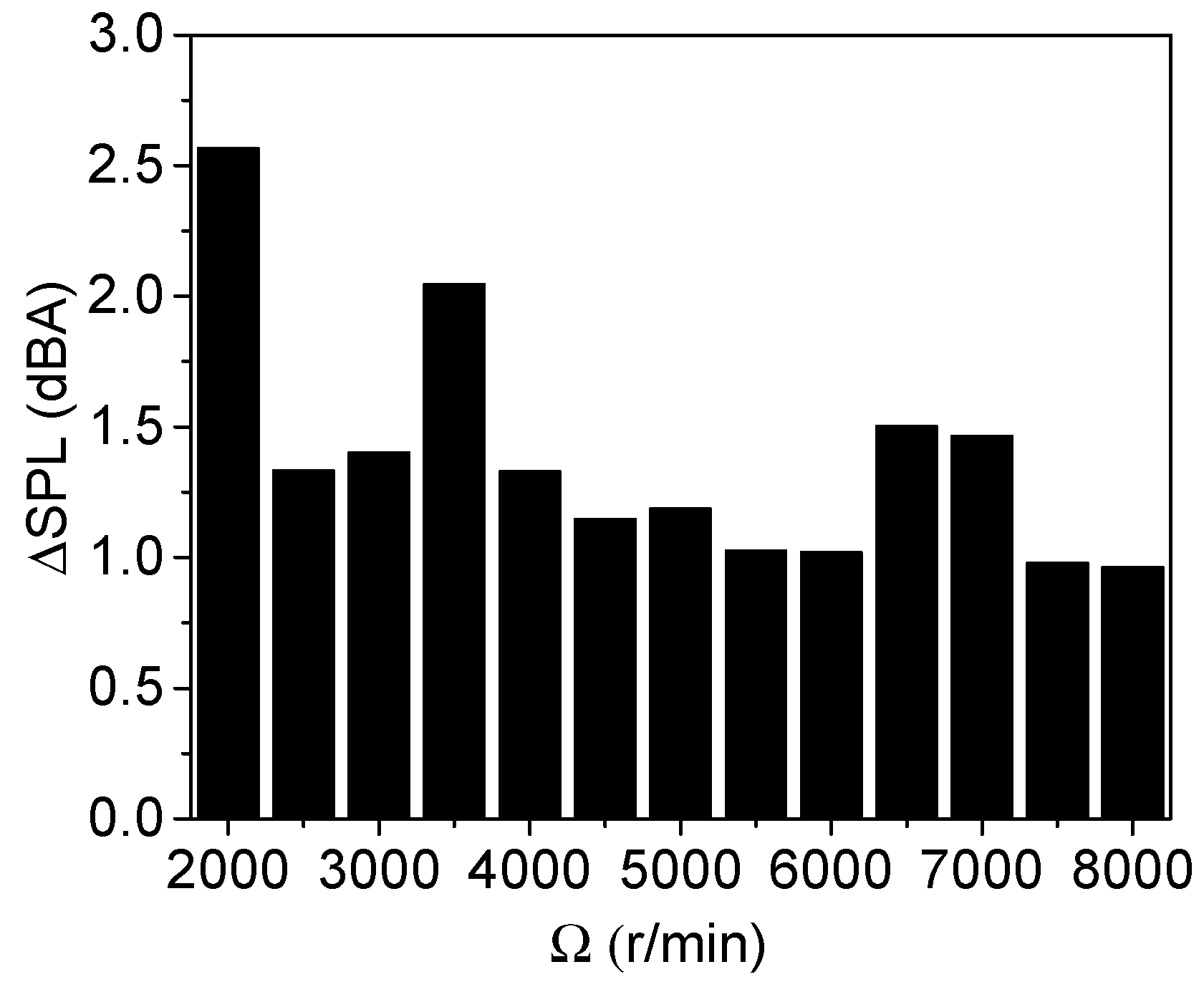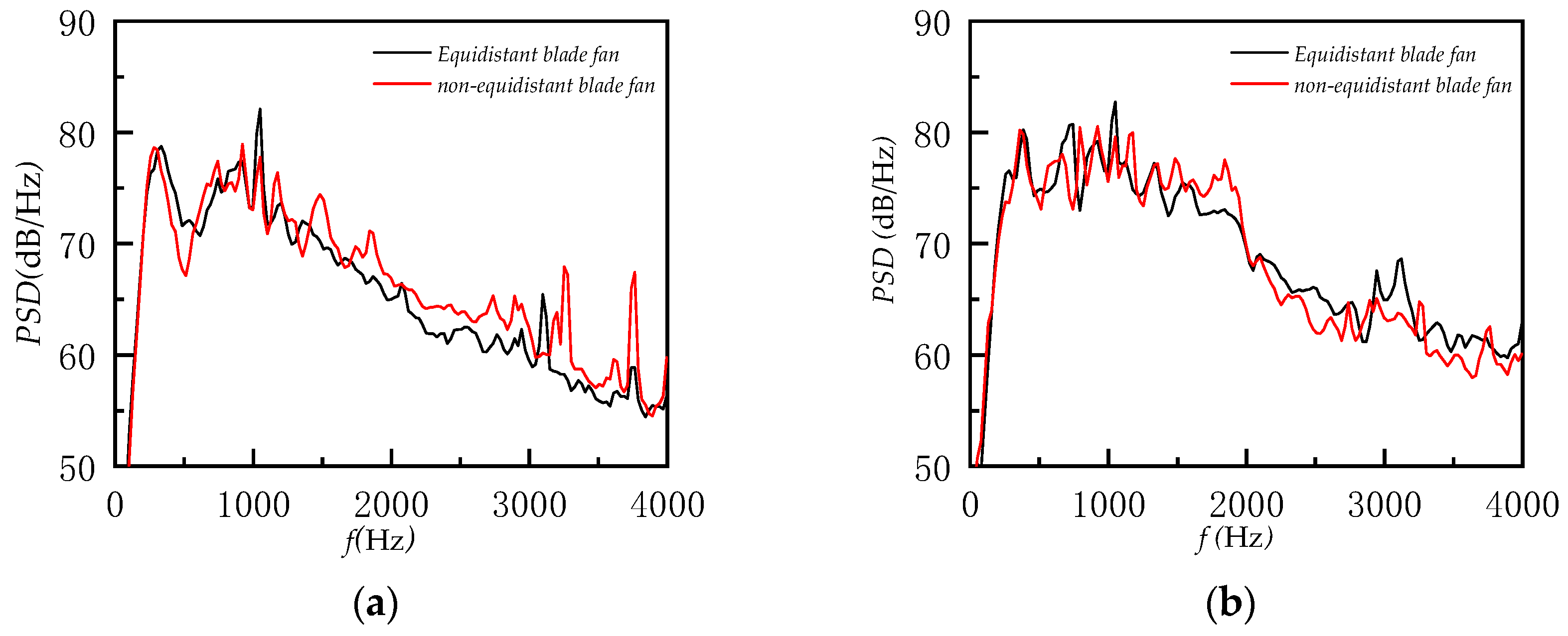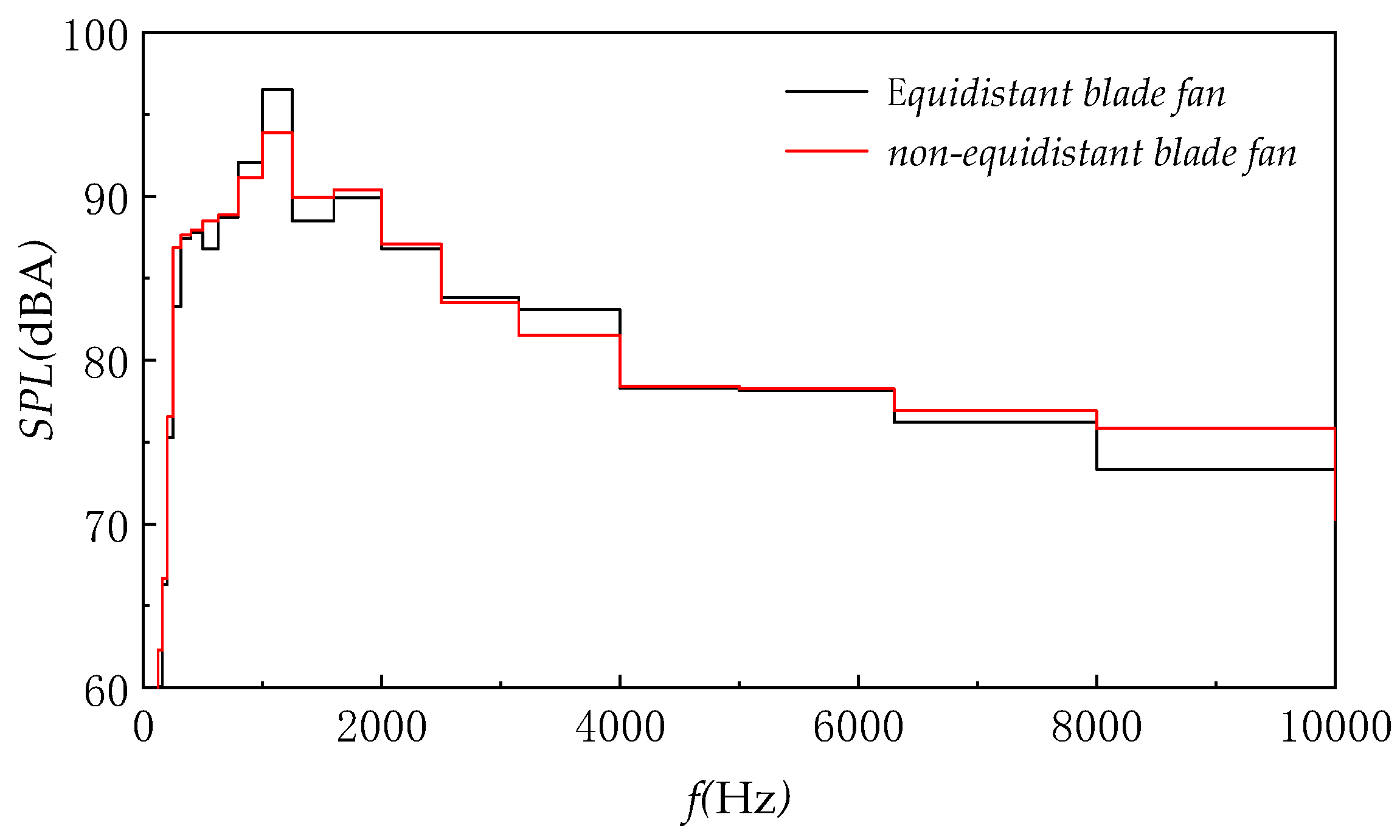Noise Reduction Design Method and Validation of Unequal-Pitch Blade Fan for Traction Motor
Abstract
:1. Introduction
2. Theoretical Background
2.1. Basic Theory
2.2. Objective Function
2.3. Restrictive Condition
3. Optimization Design
- The value of the objective function is computed using the blade distribution of the equidistant blade as the initial solution and considering this solution as the current optimal solution .
- A new solution is obtained by giving a small perturbation to the current optimal solution. The blade angle is varied in the range , where , and the new solution is computed with the value of its objective function and its increase in the value of the objective function .
- If this increase is not greater than zero, accept the new solution as the current optimal solution; if this increase is greater than zero, calculate the acceptance probability , take a random number , and when , accept the current value. Otherwise, it is not accepted. is the cooling control parameter.
- 4.
- The perturbation and acceptance process is repeated 1000 times under the same control parameter , i.e., steps 2 and 3 are performed.
- 5.
- Determine whether the temperature reaches the termination temperature level; if it is satisfied, terminate the algorithm; otherwise, reduce the temperature and proceed to the next temperature iteration until the termination condition of the algorithm is satisfied and the algorithm is terminated.
4. Test Validation
5. Analysis of Results
6. Conclusions
7. Prospects
Author Contributions
Funding
Conflicts of Interest
Nomenclature
| interference function of the rotor | position vector | ||
| the objective function | weighting function | ||
| frequency (Hz) | number of blades | ||
| imaginary unit | angular position relative to the first blade (rad) | ||
| integer number | Dirac pulse | ||
| number of harmonics of the rotor angular speed | angular speed of the rotor (rad/s) | ||
| harmonic order | blade angular displacement from the evenly spaced position | ||
| power of an acoustic pressure component at the nth harmonic | angular frequency (rad/s) | ||
| acoustic pressure, Pa | blade | ||
| maximum displacement parameter | Blade No. | ||
| sound pressure level (dB) | Superscripts | ||
| the overall A-weighted sound pressure level (dBA) | tonal | ||
| power spectrum of sound pressure (Pa2s) | relative to the evenly spaced configuration | ||
References
- Bunn, F.; Zannin, P.H.T. Assessment of railway noise in an urban setting. Appl. Acoust. 2016, 104, 16–23. [Google Scholar] [CrossRef]
- Tokunaga, M.; Sogabe, M.; Santo, T.; Ono, K. Dynamic response evaluation of tall noise barrier on high speed railway structures. J. Sound Vib. 2016, 366, 293–308. [Google Scholar] [CrossRef]
- Chaudhury, S.; Yamasaki, T. Robustness of adaptive neural network optimization under training noise. IEEE Access 2021, 9, 37039–37053. [Google Scholar] [CrossRef]
- Accardo, L.; Fioretto, M.; Giannini, G. Techniques of PWM space vector modulation for the reduction of magnetic acoustic noise in traction motor. In Proceedings of the International Symposium on Power Electronics, Electrical Drives, Automation and Motion, 2006, SPEEDAM 2006, Taormina, Italy, 23–26 May 2006; pp. 1084–1089. [Google Scholar]
- Król, E.; Maciążek, M. Identification and analysis of noise sources of permanent magnet synchronous traction motor with interior permanent magnet. Energies 2023, 16, 6018. [Google Scholar] [CrossRef]
- Gurav, R.; Udawant, K.D.; Rajamanickam, R.; Karanth, N.V.; Marathe, S.R. Mechanical and Aerodynamic Noise Prediction for Electric Vehicle Traction Motor and Its Validation. In Proceedings of the Symposium on International Automotive Technology, Pune, India, 18–21 January 2017. [Google Scholar]
- Kim, J.-H.; Ki, H.-C.; Byun, S.-J. Improving the design of the traction motor of trains to reduce the aerodynamic noise. Proc. Inst. Mech. Eng. Part F J. Rail Rapid Transit 2020, 234, 3–16. [Google Scholar] [CrossRef]
- Qu, X.; Tian, J.; Wang, T. Numerical and experimental investigation on centrifugal cooling fan in a traction motor. In Turbo Expo: Power for Land, Sea, and Air; Volume 1: Aircraft Engine; Fans and Blowers; Marine; American Society of Mechanical Engineers: Oslo, Norway, 2018; p. V001T09A011. [Google Scholar]
- Rama Krishna, S.; Rama Krishna, A.; Ramji, K. Reduction of motor fan noise using cfd and caa simulations. Appl. Acoust. 2011, 72, 982–992. [Google Scholar] [CrossRef]
- Mellin, R.C.; Sovran, G. Controlling the tonal characteristics of the aerodynamic noise generated by fan rotors. J. Fluids Eng. 1970, 92, 143–154. [Google Scholar] [CrossRef]
- Sullivan, B.M.; Edwards, B.D.; Brentner, K.S.; Booth, E.R. A Subjective Test of Modulated Blade Spacing for Helicopter Main Rotors. J. Am. Helicopter Soc. 2005, 50, 26–32. [Google Scholar] [CrossRef]
- Ewald, D.; Pavlovic, A.; Bollinger, J.G. Noise reduction by applying modulation principles. J. Acoust. Soc. Am. 1971, 49, 1381. [Google Scholar] [CrossRef]
- Duncan, P.E.; Dawson, B. Reduction of interaction tones from axial flow fans by suitable design of rotor configuration. J. Sound Vib. 1974, 33, 143–154. [Google Scholar] [CrossRef]
- Dobrzynski, W. Propeller Noise reduction by means of unsymetrical blade-spacing. J. Sound Vib. 1993, 163, 123–136. [Google Scholar] [CrossRef]
- Ma, J.; Qi, D.; Mao, Y. Noise reduction for centrifugal fan with non-isometric forward-swept blade impeller. Front. Energy Power Eng. China 2008, 2, 433–437. [Google Scholar] [CrossRef]
- Cattanei, A.; Ghio, R.; Bongiovı, A. Reduction of the tonal noise annoyance of axial flow fans by means of optimal blade spacing. Appl. Acoust. 2007, 68, 1323–1345. [Google Scholar] [CrossRef]
- Anghinolfi, D.; Canepa, E.; Cattanei, A.; Paolucci, M. Psychoacoustic optimization of the spacing of propellers, helicopter rotors, and axial fans. J. Propuls. Power 2016, 32, 1422–1432. [Google Scholar] [CrossRef]
- Jiang, B.; Wang, J.; Yang, X.; Wang, W.; Ding, Y. Tonal noise reduction by unevenly spaced blades in a forward-curved-blades centrifugal fan. Appl. Acoust. 2019, 146, 172–183. [Google Scholar] [CrossRef]
- Wu, Y.; Pan, D.; Peng, Z.; Ouyang, H. Blade force model for calculating the axial noise of fans with unevenly spaced blades. Appl. Acoust. 2019, 146, 429–436. [Google Scholar] [CrossRef]
- Peng, Z.; Wu, Y.; Tian, J.; Ouyang, H. Discrete noise control of cooling fan module: Stator and rotor interaction. Appl. Acoust. 2020, 165, 107308. [Google Scholar] [CrossRef]
- Cattanei, A.; Zecchin, F.M.; Di Pasquali, A.; Lazari, A. Effect of the uneven blade spacing on the noise annoyance of axial-flow fans and side channel blowers. Appl. Acoust. 2021, 177, 107924. [Google Scholar] [CrossRef]
- GB/T 10069.1; Noise Determination Methods and Limit Values for Rotating Motors. Standardization Administration of the People’s Republic of China: Beijing, China, 2006.
- GB/T 25123.2; Rotating Motors for Railway Rolling Stock and Highway Vehicles. Standardization Administration of the People’s Republic of China: Beijing, China, 2010.










| No. | Blade Circumferential Angle/° | ||||||||||
|---|---|---|---|---|---|---|---|---|---|---|---|
| 1 | 17.0 | 98.4 | |||||||||
| 0 | 21.2 | 42.4 | 63.5 | 84.7 | 105.9 | 127.1 | 148.2 | 169.4 | |||
| 190.6 | 211.8 | 232.9 | 254.1 | 275.3 | 296.5 | 317.6 | 338.8 | ||||
| 2 | 0 | 97.7 | |||||||||
| 0 | 30.8 | 49.2 | 67.3 | 85.3 | 103.2 | 121.1 | 140.1 | 163.3 | |||
| 196.5 | 219.9 | 238.6 | 256.8 | 274.5 | 292.3 | 310.5 | 329.2 | ||||
| 3 | 13.5 | 97.2 | |||||||||
| 0 | 25.3 | 44.6 | 64.5 | 84.7 | 105.1 | 125.5 | 145.9 | 166.0 | |||
| 194.0 | 214.2 | 234.5 | 254.9 | 275.3 | 295.5 | 315.4 | 334.7 | ||||
| Motor A-Weighted Sound Pressure Level (dBA) | ||||||
|---|---|---|---|---|---|---|
| Measurement point | 1 | 2 | 3 | 4 | 5 | average value |
| Isometric blade | 99.0 | 100.2 | 98.3 | 100.9 | 96.5 | 99.2 |
| Unequal-pitch blade | 97.2 | 99.4 | 98.6 | 98.6 | 95.3 | 98.0 |
Disclaimer/Publisher’s Note: The statements, opinions and data contained in all publications are solely those of the individual author(s) and contributor(s) and not of MDPI and/or the editor(s). MDPI and/or the editor(s) disclaim responsibility for any injury to people or property resulting from any ideas, methods, instructions or products referred to in the content. |
© 2023 by the authors. Licensee MDPI, Basel, Switzerland. This article is an open access article distributed under the terms and conditions of the Creative Commons Attribution (CC BY) license (https://creativecommons.org/licenses/by/4.0/).
Share and Cite
Li, W.; Yang, L.; Hu, A.; Wu, Y.; Li, G. Noise Reduction Design Method and Validation of Unequal-Pitch Blade Fan for Traction Motor. Processes 2023, 11, 2953. https://doi.org/10.3390/pr11102953
Li W, Yang L, Hu A, Wu Y, Li G. Noise Reduction Design Method and Validation of Unequal-Pitch Blade Fan for Traction Motor. Processes. 2023; 11(10):2953. https://doi.org/10.3390/pr11102953
Chicago/Turabian StyleLi, Weiye, Liu Yang, Ao Hu, Yuhe Wu, and Gangyan Li. 2023. "Noise Reduction Design Method and Validation of Unequal-Pitch Blade Fan for Traction Motor" Processes 11, no. 10: 2953. https://doi.org/10.3390/pr11102953







